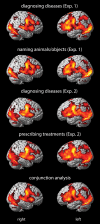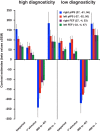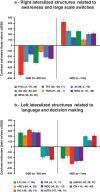How doctors diagnose diseases and prescribe treatments: an fMRI study of diagnostic salience
- PMID: 28465538
- PMCID: PMC5430984
- DOI: 10.1038/s41598-017-01482-0
How doctors diagnose diseases and prescribe treatments: an fMRI study of diagnostic salience
Abstract
Understanding the brain mechanisms involved in diagnostic reasoning may contribute to the development of methods that reduce errors in medical practice. In this study we identified similar brain systems for diagnosing diseases, prescribing treatments, and naming animals and objects using written information as stimuli. Employing time resolved modeling of blood oxygen level dependent (BOLD) responses enabled time resolved (400 milliseconds epochs) analyses. With this approach it was possible to study neural processes during successive stages of decision making. Our results showed that highly diagnostic information, reducing uncertainty about the diagnosis, decreased monitoring activity in the frontoparietal attentional network and may contribute to premature diagnostic closure, an important cause of diagnostic errors. We observed an unexpected and remarkable switch of BOLD activity within a right lateralized set of brain regions related to awareness and auditory monitoring at the point of responding. We propose that this neurophysiological response is the neural substrate of awareness of one's own (verbal) response. Our results highlight the intimate relation between attentional mechanisms, uncertainty, and decision making and may assist the advance of approaches to prevent premature diagnostic closure.
Conflict of interest statement
The authors declare that they have no competing interests.
Figures





References
-
- Hunink, M. G. M. et al. Decision Making in Health and Medicine. 2nd ed., (Cambridge University Press, 2014).
-
- Nobre, A. C. & Mesulam, M. Large-scale networks for attentional biases, In The Oxford Handbook of Attention (eds A. C. Nobre & S. Kastner) Ch. 5, 105–151 (Oxford University Press, 2014).
Publication types
MeSH terms
Grants and funding
LinkOut - more resources
Full Text Sources
Other Literature Sources

